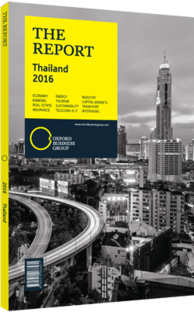Construction services
The Company
SEAFCO was incorporated in 1974, with registered capital of BT3m ($90,300) (paid-up capital of BT1.5m, $45,150 ) and a par value of BT1000 ($30). The company focused on the construction of small-diameter bored piles. SEAFCO increased its capital to BT120m ($3.6m), and changed a par value from BT1000 ($30) to BT100 ($3) in 1994. SEAFCO changed the par value from BT100 ($3) to BT1 ($0.03) and raised BT90m ($2.7m) from the existing shareholders at the price of BT1 ($0.03) per share, increasing the paid-up capital to BT210m ($6.3m). SEAFCO became a public company on March 18, 2004 and listed in www. settrade.com on September 3, 2004.
SEAFCO is a contractor of substructure and general civil works, serving customers from both the state and private sectors. The firm can directly serve project owners or act as a subcontractor for main contractors. The firm’s services are divided into the following areas: bored and barrett piling, diaphragm walling, soil improvement, civil construction and substructure works, and ancillary services. SEAFCO is a highly skilled contractor of bored pile works. It is among the country’s biggest players in the industry, with a market share of 30-50% and broad experience of 40 years. Approximately 90% of the firm’s revenue is generated by its bored and barrette piling as well as diaphragm walling services while the remaining 10% is from its civil construction and substructure works.
Development Strategy
SEAFCO is likely to benefit from the bright outlook for domestic construction growth in the next few years, which should be boosted by the government’s planned investment in infrastructure projects and the increase in the number of high-rise projects owned by the private sector. This should help to strengthen SEAFCO’s substructure work business. The firm should also benefit from economies of scale, with its existing equipment being fully utilised. This helps to lower SEAFCO’s fixed unit costs, thus boosting the firm’s gross profit margin.
Despite the rather small market value of the bored pile business at BT4bn-5bn ($120.4m-150.5m) per annum, SEAFCO benefits from soft market competition (small number of players and key players must be so highly skilled that they are trusted by customers). This factor, coupled with the market condition of demand being slightly higher than supply as well as the fact that it is rather difficult for new players to penetrate the market, allows SEAFCO to continue enjoying a solid gross profit margin.
SEAFCO expanded its business to Myanmar in 2013, operated under its 99.99%-owned subsidiary SEAFCO Intertrade. In early 2015 the firm had a backlog in Myanmar amounting to BT50m ($1.5m) and it is expected to receive another project in Yangoon. We expect SEAFCO to gain a further project in Myanmar worth BT200m ($6m) (only for labour fees), with the result likely to be known shortly. This bright outlook should help to underpin the firm’s backlog and revenue realisation. We see the opportunity for SEAFCO to continue to gain more projects in Myanmar along with the country’s growing construction industry.
Given the strong backlog at BT1bn ($30.1m) as well as the high potential for new orders from domestic customers and Myanmar, SEAFCO is expected to see its core profit increase to BT221m ($6.7m) and BT240m ($7.2m) in 2016 and 2017, respectively, equivalent to a 20% compound annual growth rate. We expect revenue realisation to rise by 10% per annum to BT2bn ($60.2m) and BT2.2bn ($66.2m) in 2016 and 2017. The gross profit margin is anticipated to widen to 20% in 2016-17 from 18% in 2015 on the back of the positive impact from the falling oil price.
We estimate SEAFCO’s debt-to-equity ratio at 0.26x as of end-2015 and expect the ratio to fall to 0.24x and 0.18x in 2016 and 2017, respectively. Although the ratio has remained low, its return on equity was high at 25% in 2014, with the level likely to improve to 21% in 2016-17 from an estimated 17.7% in 2015.
You have reached the limit of premium articles you can view for free.
Choose from the options below to purchase print or digital editions of our Reports. You can also purchase a website subscription giving you unlimited access to all of our Reports online for 12 months.
If you have already purchased this Report or have a website subscription, please login to continue.

